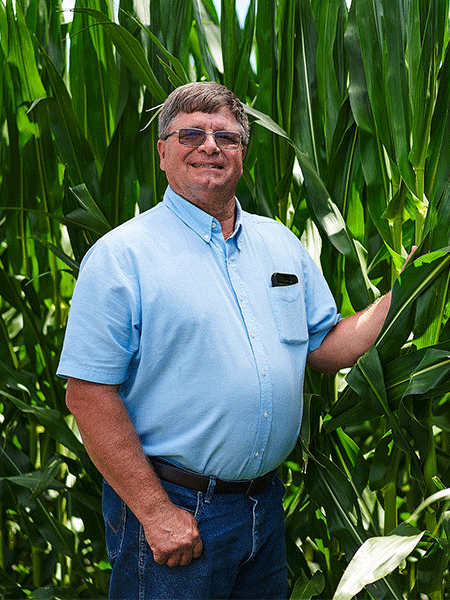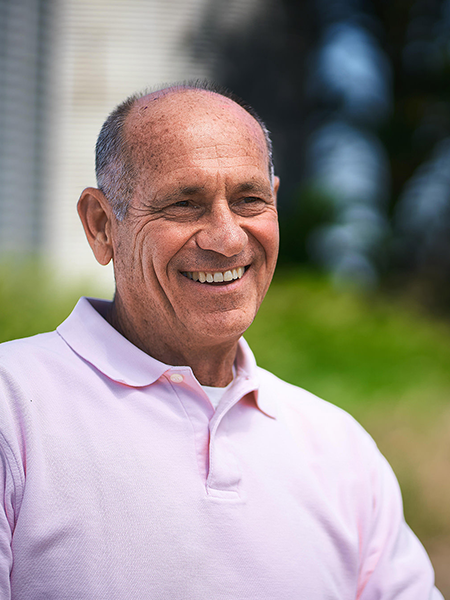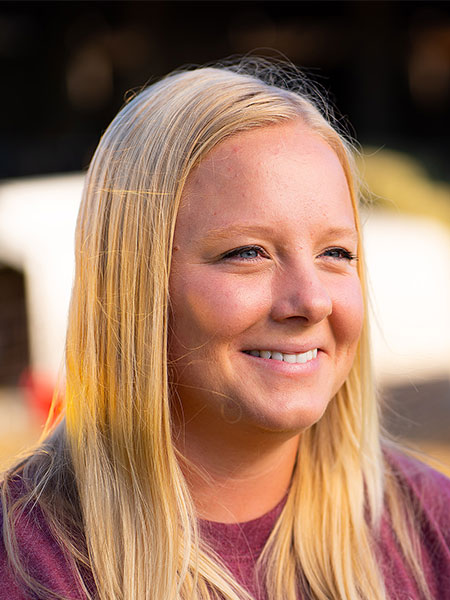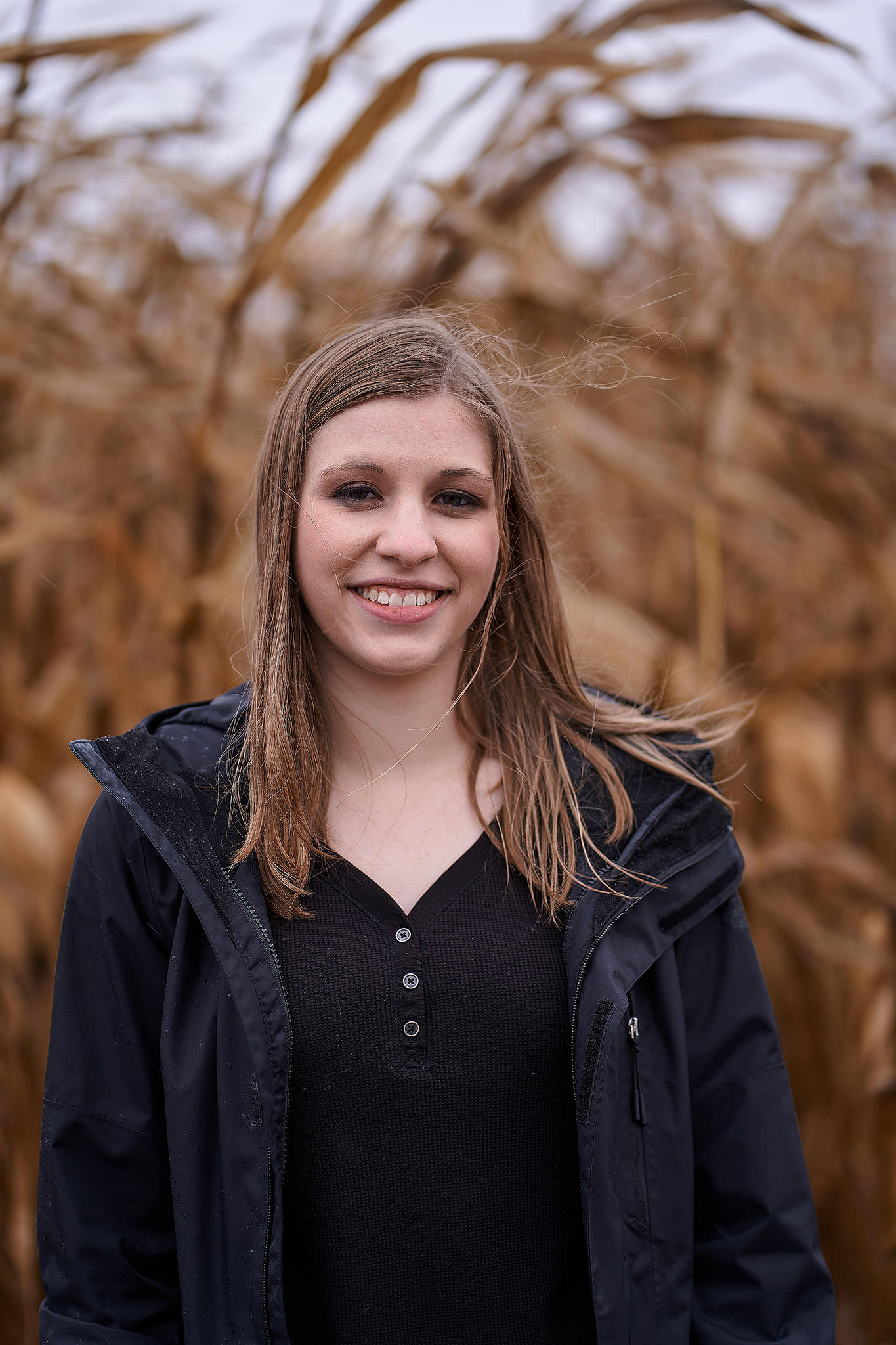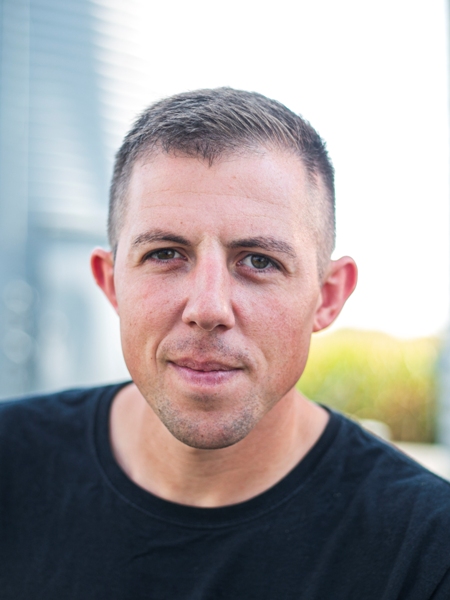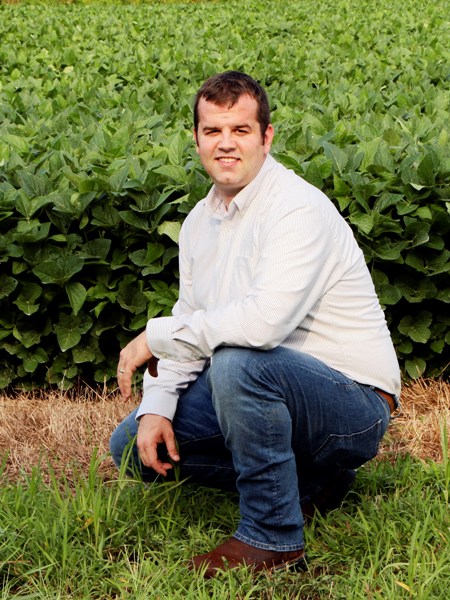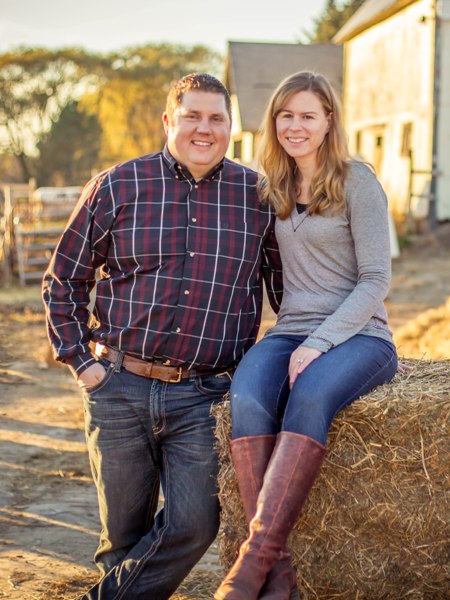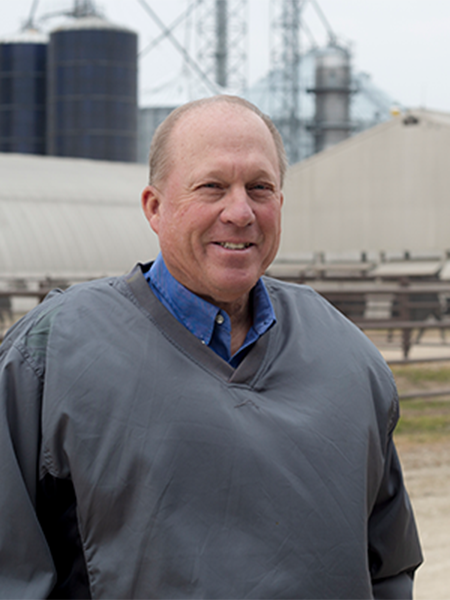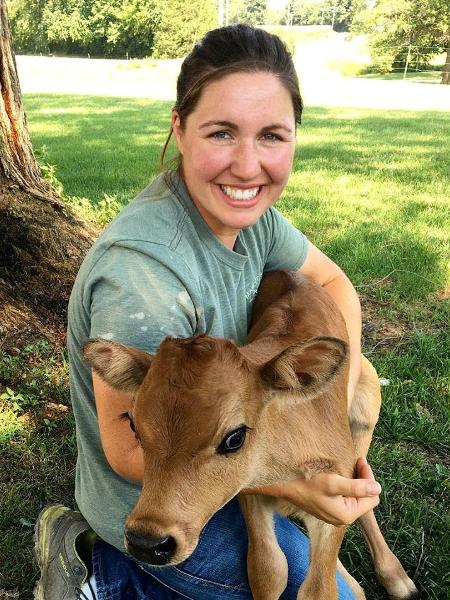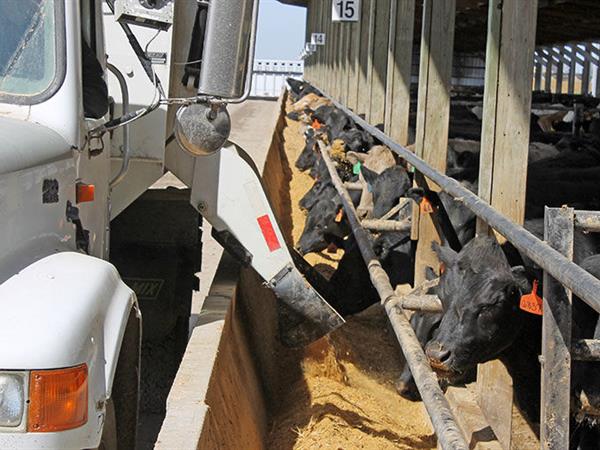Raising pigs with the principles of reduce, reuse, recycle
Raising pigs with the principles of reduce, reuse, recycle
As a pig farmer, I think about the Earth’s natural resources every day. Land, water, and air are critical to farmers and our ability to continue to provide an affordable food supply. I want to preserve and improve these natural resources, minimize waste and above all, farm in a sustainable way.
You could say we’re using the principles of the three R’s we all learned about in elementary school – reduce, reuse, recycle – to meet our sustainability goals.
REDUCE
We’re raising more pigs and more pork on fewer acres than in the past. That’s definitely a good thing because we’re also reducing our carbon footprint. The footprint of our barns is smaller today than the land that was required to raise pigs outdoors years ago. We’re also better able to care for our pigs in this controlled environment.
Pig farmers like me have made some huge improvements in our overall carbon footprints. In the last 50 plus years, for every pound of pork we raise we’re using 25% less water, 7% less energy, almost 8% less carbon and 75% less land. Raising pigs today contributes less than one half of one percent (.46%) to U.S. greenhouse gas emissions.
On our farm, I built a new barn just two years ago. The smart technology in it helps us create a climate controlled environment with feed and water sensors so pigs have access to food and water 24/7, and helps us save energy overall. In the fields, precision agriculture combined with less tillage of the soil reduces the amount of fossil fuels we use to raise crops that we use for feed and other uses
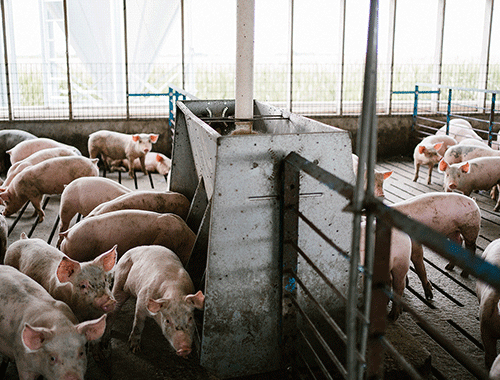
REUSE
Illinois is one of the best places in the world to raise crops and livestock. Our fertile soils are great for growing corn and soybeans that can be used for many things, including livestock feed for our pigs. Some of our feed ingredients are sourced from within a hundred miles of our farm, but otherwise what the pigs are eating is all locally grown and processed. Local crops turn into local feed and local feed creates local pork.
Crops also are used for many other purposes besides feed. Corn, soybeans, and wheat all end up in your grocery store shelves in a variety of ways both directly and indirectly. Ethanol and biodiesel, made from corn and soybeans, provide clean air alternatives that reduce emissions and improve our atmosphere, and the byproducts of those processes create healthy feed for our livestock, further continuing the cycle.
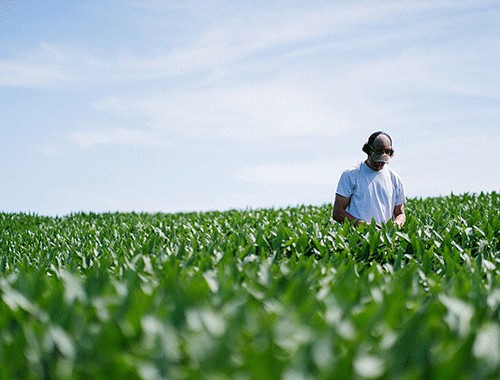
RECYCLE
Recycling is all about the valuable nutrients that come from animal waste, or manure. Every year is a new year to repeat the cycle of raising crops, feeding the crop to the pigs and then recycling the manure back onto our crop fields as a natural fertilizer. This natural fertilizer not only contains the key nutrients of nitrogen, potassium and phosphorus that crops need to grow, but it also contains micronutrients and microorganisms that add organic matter and improve soil health.
Manure from our pigs is stored under our barn and saved until it can be applied to the fields after harvest. When we apply the manure, a specialized machine applies the material below the surface of the soil. This does two things: It keeps the manure underground so rain doesn’t wash away the nutrients, and it helps control odor so we’re being good neighbors within our communities.
IT ALL ADDS UP
For me, there’s a definite sense of pride planting the seed in the spring and watching it grow. I do the best that I can to raise that seed into a productive plant and harvest the crop that ultimately feeds my pigs. It’s a satisfying experience to go into the grocery store and see a full meat case, knowing that I had a part in helping supply quality meat.
So the next time you’re enjoying a great meal with pork tenderloin, pork chops, sausage, bacon – you get the idea – you can eat happy knowing that livestock farming is sustainable and provides quality protein for your family and mine.
A climate change solution: carbon sequestration
A climate change solution: carbon sequestration
Scientific evidence suggests that current climate change events are connected to rising levels of carbon dioxide in our atmosphere and human activities, primarily burning fossil fuels. Combating this change has become one of the defining issues of our world today. The good news is that farmers are in a unique position to help by capturing carbon from the atmosphere and storing it in our soil.
Here’s how it works.
It starts with a lesson we all learned in elementary school science. Through the natural process of photosynthesis, all plants take carbon dioxide (CO2) out of the air and convert it into sugars the plant and soil microorganisms need to grow. This capturing of carbon – or sequestration – is beneficial because it reduces the amount of carbon in the atmosphere (good for all of us) and improves soil health (good for farmers, and good for all of us because it improves our ability to grow your food).
Our soils also have the capacity to store two to three times more carbon than they currently do. You see, as populations grew over the last 100 plus years, forests and prairies were converted to farmland, and that land was tilled to grow crops. Every time the soil is tilled or turned over, carbon that is in the soil is released back into the air.
Farmers can have a positive impact on climate change by doing lots of things, but two main ones are
1) reducing the amount of carbon lost to the atmosphere by tilling the ground less and 2) adding even more plants to take additional CO2 out of the air.
Let’s talk about tillage first.
Less tillage = more carbon in the soil
In the 35 years that I’ve been farming, there has been an evolution on how we manage our soil. When I was a little kid, everybody moldboard plowed, which is taking the soil and turning it over where it’s black on top. My dad was one of the first to adopt chisel plowing in the 1970s, which is tilling the soil, but leaving some plant material on the surface. Now many farmers do what I’m doing with my soybeans – leaving entire plant residue, which is left over from harvesting the previous year’s corn crop, on top of the soil and planting straight into it. This no-till method improves overall soil health by adding more organic plant matter and saves me trips across the field with equipment, lowering my emissions and keeping the carbon in the soil.
More plants = more carbon captured from the air
Another opportunity farmers have is planting cover crops. These are crops like grasses that are planted and grow through the fall, winter and spring. They are not harvested for food but are left in the field before planting the new crop to add more carbon and reduce soil erosion. They also sequester more carbon as they grow.
Farmers care for 75% of all the land in Illinois. You can quickly do the math and imagine the positive impact we can have on our world as more and more farmers adopt these farming practices.
Ag tech helps us get there
Numerous technology advances also help with carbon sequestration. Farm equipment is more efficient and means less fuel use and fewer trips across the field. Today’s seed traits adapt to dry weather conditions, so we don’t have to replant and use more energy. Advancements in precision agriculture have allowed us to monitor and manage specific areas in a field, such as only applying herbicides in areas of the field with known weed issues. These precise applications reduce my carbon footprint by saving fuel, disturbing the soil less and helping prevent soil erosion. All of these things and more give farmers additional opportunities to help solve our carbon problem.
Doing my part to capture carbon and improve soil health is just one way I’m being sustainable. Sustainability to me means that I had the opportunity to farm this beautiful place. And maybe in a few years (I have three new grandsons), maybe one of them will take my place and find even more ways to protect our resources, and our planet.
Protecting our pollinators
Protecting our pollinators
When I think of butterflies, I think of the monarch and its iconic black and orange pattern. And as farmers, I think we’re perfectly positioned to be partners in solving the plight of the monarch butterfly.
As I understand it, 90% of monarch butterfly populations have decreased over the last 20 years. And because scientists estimate that one of every three bites of food we eat are directly dependent on pollinators like butterflies and bees, it’s hugely important that we do everything we can to support pollinators, including monarchs.
Illinois is particularly important to the monarch because we’re right in the middle of their migratory path between Mexico and Canada.
Decrease in habitat led to decreased populations
There are many reasons monarch butterfly numbers have declined, but the main ones are habitat loss, urban development and changes in farm practices. On the farm side, we’ve done such a good job controlling the weeds in our fields that there’s been an unintended consequence: Milkweed – the main source of food and habitat for monarch butterflies – can be hard to find.
As a child, I spent a lot of hours walking soybean fields and hand chopping milkweed and other weeds. Today, we have sophisticated weed control products that do that for us, so now we’re finding ways to bring milkweed populations back in other areas of the farm.
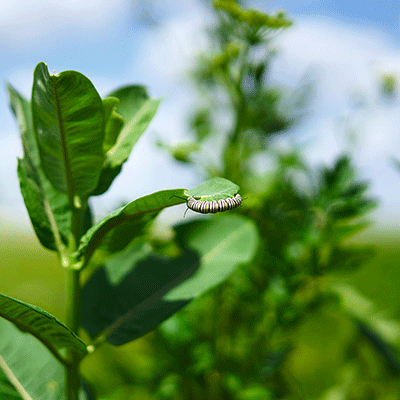
Together, we’re bringing back the monarchs
If you’d told me 10 years ago that I’d be planting milkweed, I’d have called you crazy. Because of the amount of land we care for, I know now that farmers are in a unique position to help pollinators.
I started my pollinator plot with a flat of milkweed stems. I planted most of them on land already being used for other conservation projects – a strip of land next to one of my fields – but saved a few for my landscaping beds in the backyard. What I noticed is they’ve been extremely easy to grow. I basically planted them and then let them be, and they really thrived.
As that first growing season progressed, I became concerned when I noticed the plants were being decimated. I looked closer and found that monarch caterpillars were eating the milkweed. That’s exactly what was supposed to happen.
I’ve seen the difference firsthand. It’s like that old saying, “If you build it, they will come.” If you plant pollinator habitats, the butterflies will come. Since planting my milkweed, I’ve definitely seen more monarchs around the farm.
And I’m not alone. There’s a coordinated effort with agricultural and other advocacy groups to increase pollinator habitats. A lot of others are working on this issue, and Illinois is one of the leading states in planting habitat that supports pollinators. In the last 10 years, more than 100,000 acres have been planted with pollinator-friendly plants in Illinois alone.Everybody has the opportunity to be part of this, even if you only have a small backyard garden or flower bed.

Good for pollinators, good for us all
We feel very passionate about trying to leave the world in a better place, and pollinator plots are just one solution. It’s very easy to do, and it’s the right thing to do.
Making milk’s carbon footprint even smaller
Let’s talk about carbon footprints.

Everyone probably realizes that everyday activities like shopping, working, commuting to work and countless other things all create emissions and your own personal carbon footprint. What you may not know that here in the U.S., the top three contributors to GHG emissions are transportation, electricity and manufacturing. Animal agriculture, including dairy farms like mine, sometimes get a bad rap for their contribution to GHG emissions. I’d like to share a little about dairy’s impact and what we’ve done and are doing to improve.
Agriculture in the U.S. – including all aspects of growing and raising fruits, veggies, grain crops and livestock – account for 10% of all emissions. Raising dairy cattle, processing milk into dairy products, getting them to your table and even the waste from packaging dairy products accounts for just 2% of total GHG emissions.
Dairy farms like ours have made steady improvements to get to that number. My parents did things better than my grandparents, and my brothers and I will do things better than my parents. That’s just the nature of our business and our commitment to always improving. The data demonstrates that improvement. In a 10-year period between 2007 and 2017, dairy farms decreased their total GHG emissions by nearly 20%.
One of the biggest contributors to those reductions has been how we grow crops and feed our animals. Dairy farmers work with nutritionists – like registered dietitians, but for cows – to fine-tune diets. Why? Because this results in the most efficient use of resources while providing optimum nutrition for the right stage of the animal’s lifecycle. That makes cows today much more efficient at turning feed into high-quality milk than even a few generations ago.
On our farm for example, we take crops that we grow in our fields, like corn and alfalfa, and mix them into a balanced feed ration with minerals and other byproducts. Each group of animals on the farm gets a specific “recipe,” or diet, and each bite of that feed has the right combination of carbs, fiber, fats, etc. It’s like total performance nutrition athletes use.
But wait, there’s more
Feed efficiency is just one improvement. The way we grow our crops is another. Improved seed genetics and precision farming technology like energy-efficient planting and harvesting equipment and GPS allows us to grow more feed on fewer acres with fewer resources, like fossil fuels.
On our farm, building a modern milking parlor was another major investment to improve how we do things. This new barn uses energy-efficient milkers and LED lighting to reduce electricity use. We’ve also improved our overall environmental sustainability by recycling water multiple times, first to cool down the milk and again to wash and clean the milking parlor.
And then there’s the manure. Years ago, farmers looked at manure as a liability versus an asset. Today it’s a valuable natural fertilizer. Because of science and technology advancements, we now know the specific nutrients and micro nutrients that manure offers (nitrogen, phosphorus, potassium, magnesium) and can manage those nutrients to the specific crop needs. For example, soybeans need more nitrogen to grow than corn.
So, we have more efficient ways to grow crops for feed. We have more efficient ways to use that feed, which allows cows to give more milk. And we have a waste-turned-valuable byproduct to further improve. These all add up to more sustainable farms and more sustainable food.
Never satisfied
Progress to date has been great, but we know as a dairy community we can do even better. We’ve set out to achieve some aggressive sustainability goals by 2050, including becoming net carbon neutral or better, further optimizing water use and improving overall water quality. To meet those goals, we’ll find new ways to measure data, analyze it and make choices that lead to a more sustainable farm overall. One that hopefully the next generation can take over, just like I have.
Local farms, local families, local milk
What I’m most proud of on our farm is how well my family and I work together, and the things we’ve accomplished just in the last few years of working together. As a young farmer, I look forward to seeing where the farm goes and how we’ll change in the future.
I also love that I’m producing a local product for my local community. Unlike other foods that can travel hundreds of miles to reach grocery stores, milk and dairy products are very local. We work hard to ensure you’re getting a very nutritious product you can feel good about. Keeping our farm sustainable is good for many things. It’s good for the cows, it’s good for the farm, it’s good for the environment and it’s good for our community as a whole.
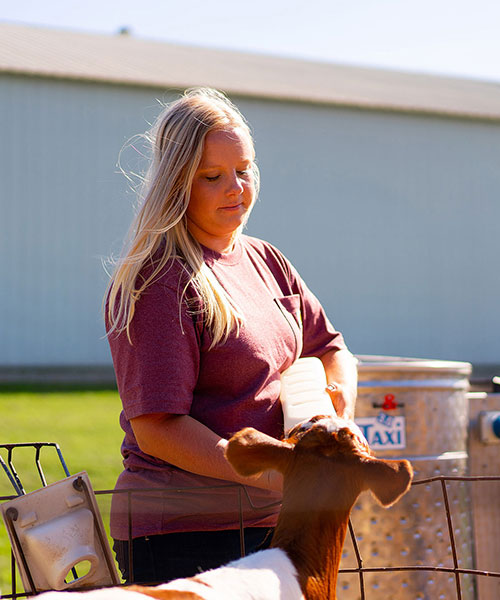
Sustainable beef strengthens soil health
Sustainable beef strengthens soil health
It may seem obvious, but when you realize that 95% of all the foods grown in the world come from the soil, protecting this vital resource becomes incredibly important to maintaining a sustainable food supply. As the world continues to grow in population, we need to adopt the best farming practices that keep our soils productive.
Protecting our state’s most valuable resource
Illinois has some of the most fertile soil in the world and farmers want to keep it that way. As the stewards of this land, we take seriously the responsibility to protect and improve this resource and are constantly making changes to how we farm. I’ve got seven grandchildren, and my hope is that at least one of them will be here to keep farming. So, I need to do whatever I can for future generations to thrive here and help feed their family and yours. And that starts with quality soil.
Soil health can be hard to define, but you definitely know it when you see it. When you go out into a field and you see the good structure of the soil, and its ability to absorb moisture and create biological activity – that’s healthy soil. Adapting soil health practices is a process, and it takes time to really start seeing the benefits of these practices. But a healthy soil really does make a healthy crop, and that’s the most important thing we’re after.
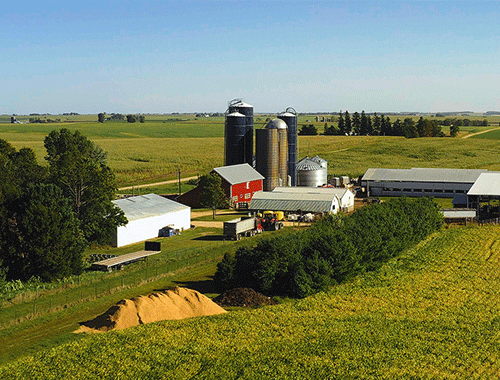
Grounded in innovative soil health practices
Today there’s a renewed interest in regenerative farming practices that help preserve and restore our soils. From one generation to the next, farmers are finding better ways to use these practices to protect our land. Cover crops are a great example. These crops are planted not to be harvested but are planted in the fall after our corn and soybeans are harvested. Cover crops help cover the soil over the winter and protect it from erosion so that our good black topsoil doesn’t wash away. These crops also provide the ground with a living root system that helps air and water move through the soil. When the cover crop is terminated at planting time it decomposes and puts nutrients back into the soil.
Our beef cattle also play a role as we can use some of the cover crop as a food source and as bedding for our livestock. There are a lot of benefits to cover crops, and every year we’re learning to improve these practices even more.
Turning unproductive land into
high-quality protein
We have traditional crop land to grow the grain crops that feed our beef cattle, but we also have wide-open pasture ground that’s beneficial to our livestock farm.
A lot of the land in northwest Illinois is steeper and not productive to grow crops. Instead, we can use the pasture ground for our cattle because it allows them to graze on the grass while getting plenty of exercise, providing the opportunity to convert a product not consumable for people (grass) into a high-quality protein source (quality beef).
A regenerative cycle
I would explain regenerative agriculture as trying to “put back” as much as you’re taking out of the soil, or more, regenerating and rebuilding that soil so we have productive farmland for years to come.
It’s actually a pretty unique cycle. We have healthy soil to grow good crops. And we’ve got the livestock that will consume those crops. But also, as they consume those crops, we have a byproduct – manure – to put back in the soil. That’s part of the reason for the livestock on my farm, it gives us something to put back. There are regenerative qualities of that manure that just can’t be bought. To be good stewards of the environment, we try to utilize all the nutrients that we can capture from the manure and put that back where it’s needed most – the soil.
Farmers are getting in front of changing weather
Weather is changing, so are farmers
 Weather is changing. And it is the No. 1 factor that will either contribute to or detract from our potential yield for our crop. A couple years of bad weather in a row, and my farm’s future is at risk.
Weather is changing. And it is the No. 1 factor that will either contribute to or detract from our potential yield for our crop. A couple years of bad weather in a row, and my farm’s future is at risk.
I only have one shot to get our crop planted at the most opportune time, and weather plays the biggest role in determining when I can get into the fields to plant in the spring. That’s important for you and me because Illinois corn and soybeans play a major role in a trillion-dollar global food supply. So, if I have bad year weather wise, chances are the rest of the world is going to notice – including you.
Adapting to weather changes
All farmers know weather is one of the things we can’t control. What we can control is how we respond to the long-term changing weather patterns we’re experiencing.
In the last five or so years, I’ve noticed a lot of weather volatility on our farm. We’ve planted crops as early as we ever have. And then in the following years, we’ve planted them later than we ever have. It seems like if we get in a weather pattern, they are very extreme. We either have extended periods of drought, or we have extended periods of heavy rainfall or extreme patterns of heavy heat followed by extra cool for the season. It’s just a lot of volatility, and crazy weather swings.
For example, over the last 70 years, rainfall within the growing season – April through October – has increased an average of 5 inches a year, and those rains are coming from bigger rainfall events. Since 1980, the number of days it has rained more than 2 inches in a single day in Illinois has doubled. This one change affects farmers in two big ways.
First, more rainy days in spring means fewer sunny days to plant. We have a window of time that we need to get our crop seeds planted. Finding the right time to plant in spring is both an art and a science. Plant too soon, and a cold snap could impact the seed already in the ground and keep it from germinating altogether. Plant too late, and we miss out on days for the crop to mature and reach its full yield potential.
We look at detailed weather forecasts to see when it’s go time for us. For farmers, spring planting is what we wait for all winter, and we’re all anxious to get going, so waiting even a few days requires a lot of patience. It helps to know I’m making the decision based on the best technology available, modern weather forecasts and modeling.
Second, more intense rainfalls and other extreme weather like hail and windstorms mean more impact to the crops when they are growing. I’d much rather get four half-inch rainfalls over the course of summer than one or two big storms that bring all the rain at once. Because of these larger rainfalls, we’ve adapted our farm practices to conserve soil, prevent erosion and keep our crops growing – hard rains tend to either wash away soil or leave water standing in the field, and both are harmful to the crop and our farm.
Soil health improvements help
Here’s where the makeup of our soil, our most valuable resource, can help. Like other farmers, I use a combination of practices to conserve and improve soil health. The first one is installing drain tiles under the soil surface so that excess water drains off the field. Buffer strips at the edges of fields slow down the water and keep the soil from going with it. Another example is no-till farming practices. By not plowing under the remains of last year’s crop, we keep that organic matter on the top of the field, and it catches the rain, allowing it to soak into the soil.
I can also improve my soil health by testing it regularly to see how fertile it is and what nutrients it needs and compare it to yields from that field last year. Satellite and drone images show me which areas of the field are growing best, and we collect data from every field. This collection and aggregation of data has changed how we farm, as we have a lot more tools that we can monitor and make changes from year to year or even within one season.
Total job satisfaction
Like me, I would say most farmers farm because they love the satisfaction of planting a seed and seeing it grow to harvest. Every day I get to look out and see something that I planted grow.
On a very small scale, I contribute to the big-picture economy, and maybe something that I grow goes and fuels a car or feeds a person. I like to be part of that at a small level. There’s something so basic about putting something in the ground and nurturing it, and then harvesting it, and then sending it down the food chain and hoping that it gets to where it’s supposed to be and does something good.
Growing a better environment with bioplastics
Growing a Better Environment With Bioplastics
 I have several friends in college who don’t know much about agriculture because they didn’t grow up in it, so I get lots of questions about farming, farm sustainability and the environment. Especially when it comes to technology and the ways we’re improving. It’s not too surprising; we’re a generation that’s very environmentally conscious. So let’s talk about plastics and bioplastic alternatives.
I have several friends in college who don’t know much about agriculture because they didn’t grow up in it, so I get lots of questions about farming, farm sustainability and the environment. Especially when it comes to technology and the ways we’re improving. It’s not too surprising; we’re a generation that’s very environmentally conscious. So let’s talk about plastics and bioplastic alternatives.
We all know about using too much plastic; in particular, single-use things like water bottles, takeout food containers, even straws. Did you know that across the globe, a million water bottles are bought every minute? That’s more than 1.4 billion water bottles every day. And of those, 91% are never recycled*. That’s why it’s rare to see a student without a reusable water bottle on campus these days. And we’re getting more mindful about passing on that straw or opting for reusable containers.
But the thing about traditional plastic is that it’s made from petroleum, which is a finite resource. And, most recycled plastic still ends up in the landfill**. A lot of my friends would be surprised to find that out. As a whole, we’re not very knowledgeable on where plastic comes from – or what better, surprising options might be growing just outside our college town.
A renewable choice
Corn is already a versatile grain used in food and fuel, and it can even play a role in our renewable future – through bioplastics. First, corn starts out in the field where we grow it. Once it’s harvested and sold to different companies, they take it and make it into different things such as clothing, carpet, shoes and other bioplastics. Anything you can make from petroleum-based plastic you can make with corn. And here’s the best part: unlike petroleum products, bioplastics made from corn (because they are bio or naturally based) don’t add carbon to our environment.
Unlike petroleum, we can grow corn right here in Illinois, and we can grow it for future generations too. It’s not something that will eventually run out. Plastic will probably always play a big role in our lives, no matter the steps we take to eliminate it. So, why not opt for a better version of it with homegrown corn? If you’re like me, when given the choice, I’ll choose the more environmentally friendly option and look forward to seeing more corn-based bioplastics on the market as they’re made available.
Sources:
*https://www.earthday.org/2018/03/29/fact-sheet-single-use-plastics/#_ftn3
**https://www.theatlantic.com/technology/archive/2019/03/china-has-stopped-accepting-our-trash/584131/
Growing biofuels as renewable energy
lets us all breathe a little easier
Growing biofuels as renewable energy lets us all breathe a little easier
When I was in middle school, the science teacher would say, “Someday, we’re going to run out of fossil fuels.” We’re still finding new reserves, but that won’t last forever. We’re drilling deeper and finding dirtier oil, which makes refining it more expensive. And we’re fracking to find more sources of natural gas.
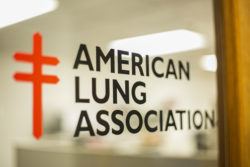 Besides being limited resources, coal, oil and gas increase air pollution by driving up CO2 emissions and other greenhouse gasses that contribute to climate change. Air quality researchers have linked these emissions to increased respiratory diseases and other health problems.
Besides being limited resources, coal, oil and gas increase air pollution by driving up CO2 emissions and other greenhouse gasses that contribute to climate change. Air quality researchers have linked these emissions to increased respiratory diseases and other health problems.
These same researchers tell us that somewhere between 40% and 70% of air pollution comes from mobile transportation, which is still mostly gasoline powered. (I don’t run into much traffic in rural Illinois, but driving through Chicago at rush hour definitely makes me think twice about air pollution.)
Biofuels to the rescue
The good news is, Illinois farm families are already growing biofuels – renewable replacements for fossil fuels that have a smaller environmental footprint. Biodiesel is made from soybeans and ethanol is made from corn. Illinois farmers grow more soybeans than any other state, and we’re No. 2 in corn behind Iowa. That’s also good news, when you consider that U.S. energy consumption is expected to grow by 50% in the next 10 years.
By increasing the use of biofuels like biodiesel and ethanol, we’re decreasing the amount of harmful emissions from gasoline. This helps improve air quality. Ethanol alone can reduce greenhouse gas emissions by about 40% compared to regular gas.
People who run equipment indoors (think warehouses) like to use biofuels because they burn cleaner with fewer fumes. If it’s better inside, why not use more of it outside to make our air cleaner?
Practicing what I preach
I’m a fifth-generation farmer. Along with my dad and grandpa, we grow corn and soybeans and run a trucking company. And when we’re not in the field planting or harvesting, I spend eight to 12 hours a day driving a semi that runs on biofuel.
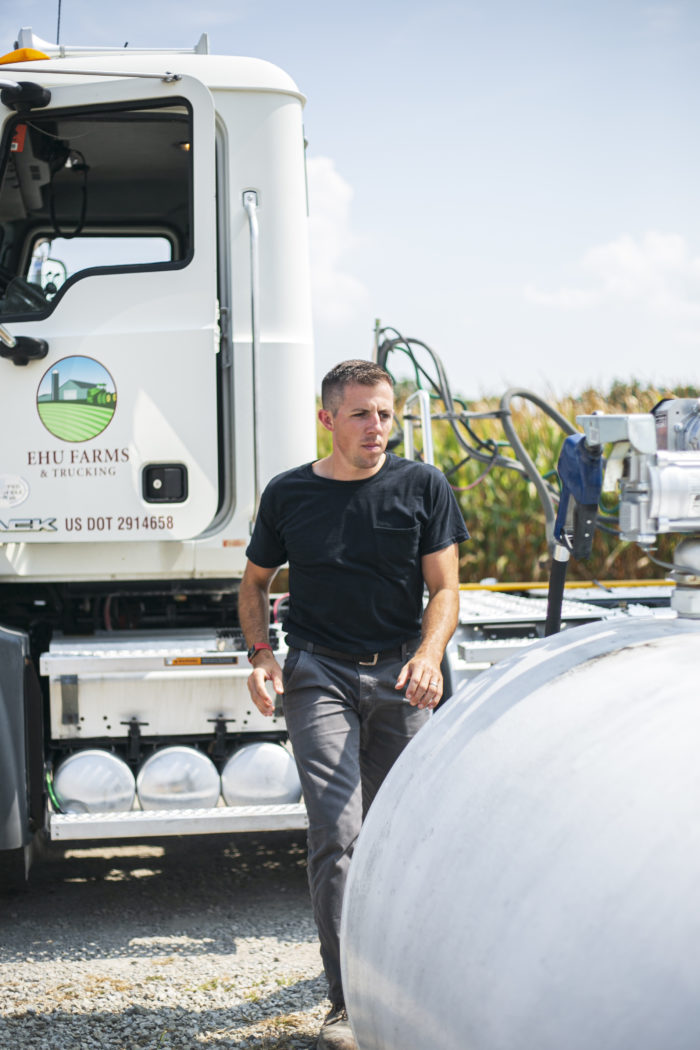
I fuel up with E11, which is 11% biodiesel that’s made from the soybeans we grow in our fields. So I’m using a product that I helped create, that we can regenerate every year, and that’s better for the environment.
Farmers want clean air just like everybody else. So if we can grow biofuels that help clean the air and save the environment – and that’s a sustainable energy source for many generations to come – that’s a no-brainer.
You hear it everywhere, how everybody loves “locally grown.” Well, there’s nothing more locally grown than biofuels made from Illinois corn and soybeans. If you drive a flex-fuel vehicle, you can choose a blend of up to 85% ethanol (E85) at the pump. If not, you can still fuel up with a blend of 15% ethanol (E15) as long as your car is model year 2001 or newer. If your vehicle runs on diesel fuel, chances are you can opt for biodiesel without any issue. By using locally grown biofuels, we’ll leave the earth a little better than we found it.

Working To Farm
Up until November 2019, Drew Kuhn worked as a production manager for Sturtevant Hog Farms (learn about that role here). Last fall, he, his wife and his brother had an opportunity to raise pigs a little closer to home. The new farm is in Sycamore (one of the 96% of all Illinois farms that are family owned), and together the Kuhn family is raising pigs from the time they’re weaned – about 3 weeks of age – to when they’ll go to market. Here’s a day in the life in his new role.
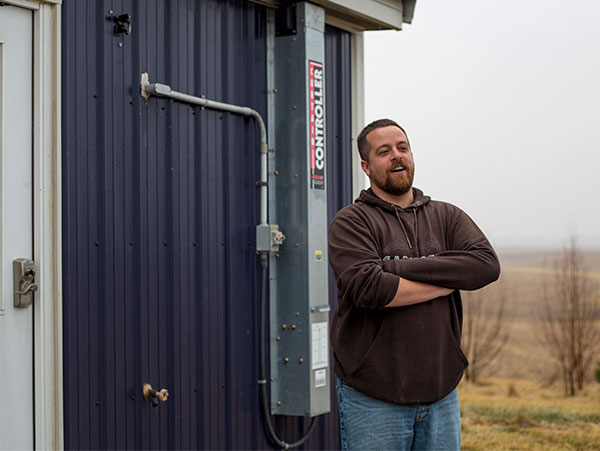
5:00 a.m.: I get on the road, taking the 15 minute drive from my house in Genoa to the Farm in Sycamore. This is much nicer than the drive time I used to log when I was managing multiple farms in different areas.
This morning is an early start because we are transporting out a load of market-ready pigs.
5:15 a.m.: As I am pulling up to the farm I’m always checking to make sure that my barns are operating properly on these cooler fall nights and the occasional hot day. My barns are natural ventilation barns, with curtains on each side that use natural airflow to help control temperatures inside. With the cooler overnight temperatures, I’m looking to make sure the curtains are up to help keep the barns a little warmer.
As I get into the barn office, I put on coveralls and get ready for the semi to show up to load pigs. Yesterday I marked pigs that were ready for market, and today they’ll be sorted and loaded onto the trailer.
The sorting takes lots of teamwork on our farm, so usually on mornings that we load out I have extra help. My dad, mom, brother and another family member usually help with loading/sorting pigs.
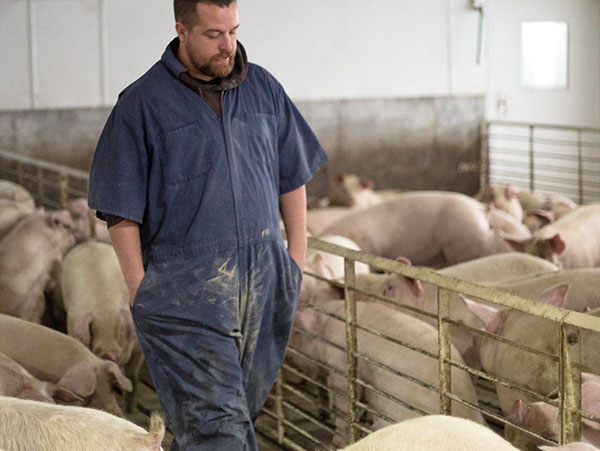
6:00 a.m.: The semi arrives and we start to sort and load. Our process has improved over the last couple of months, as we are now marketing our third group of pigs out of the farm. Each person picks a task of sorting or moving pigs down the hallways to where the semi is waiting. We move from pen to pen getting the biggest market-ready pigs out and off to market.
7:30 a.m.: We are done loading pigs – so now it’s time for talking about what else we have planned for the day.
8:00 a.m.: Everyone has left from loading and I am now onto my normal tasks for the day, which begins with checking the rest of my pigs.
I start out by doing nursery chores. These are the barns that the baby pigs come into and stay for 8 weeks before they are moved out to our finishing barns (where they grow to market weight).
I take my time walking through each of the nursery pens, checking each and every pig in the pen making sure there are no health-challenged pigs in the groups. I am also making sure the temperature and environment is set up properly for the pigs.
It’s a slow, deliberate process so that every animal can be monitored. Health can change quickly, even from one day to the next, and can impact an entire barn. It’s critical to determine if a pig needs on-the-spot treatment or should be moved to the sick pen to recover.
After checking nurseries, I move onto my pigs that are in the finishing barns and walk the groups, again checking pigs and temperatures in the barns.
9:30-2:00 p.m.: After finishing chores, I move on to making feed for the pigs. While some farmers have feed companies mix the rations for them, we order in all the ingredients and make the feed on site for the pigs. Most days this is the longest part of my day. Today I had six batches of feed to make, that way our pigs had plenty of food in their feeders to keep growing. Our pigs are fed mostly a corn and soybean meal ration that has some other added ingredients like vitamins and minerals as well. On our farm we have a feed room that we use to mix each batch of feed. That feed is then loaded into a feed truck, which is driven to each bin and unloaded.
2:00-4:00 p.m.: I check on my pigs again, similar to morning chores where I’m walking pens to make sure there were no changes throughout the day. Then I head home to Genoa to spend some family time with my wife and our newborn daughter. All to get up and head back to the farm tomorrow.
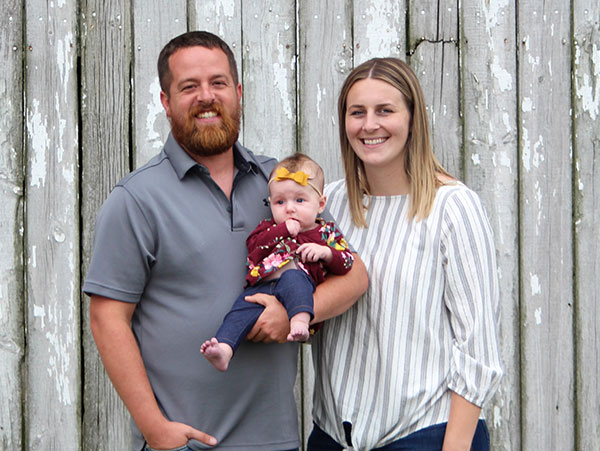
The Power of a Seed: GMOs and CRISPR
The Power of a Seed: GMOs and CRISPR
I’ve been farming for nearly half a century, so you could say things look a little different today than they did when I was planting my first crop of corn and soybeans in Central Illinois. Like many other professions, technological advances in farming have changed a lot of aspects of my job. With a boss like Mother Nature, I’ve endured a variety of challenges over the years, so I am grateful to have these technological advances as a tool to help me succeed in growing food, feed and fuel for our world.
One of those new tools is a seed – small enough to fit on the tip of my finger, but made with technology that can impact far more than just my farm.
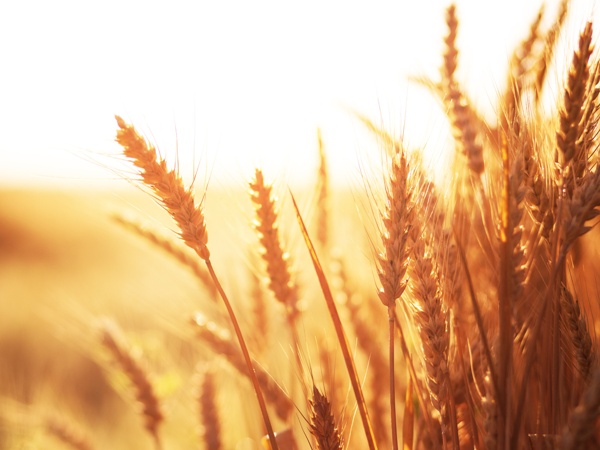
GMO vs. CRISPR
The genetic modification and gene editing processes use modern technology to speed up the development of plants to meet our 21st century consumer needs and desires while maintaining the highest level of food safety.
You may have heard of CRISPR; full name CRISPR-Cas9. While this technology modifies a plant, it doesn’t necessarily result in a genetically modified organism (GMO). This technology is being heavily discussed and likely will appear on grocery store shelves in the near future.
An article written in the American Council on Science and Health describes a genetically modified plant as one where genes from other plants are inserted into a plant to cause desired genetic improvement. This technology has been used in crops such as soybeans, corn and rice to improve yield, reduce the need for pesticides, and in the case of rice, to improve the nutrient (vitamin) value.
CRISPR, on the other hand, does not introduce foreign genes into a plant but modifies the plants own gene structure by, in simple terms, turning genes on or off in order to achieve desirable traits (an allergen-free peanut, for example).
Is it safe?
Any plant that has been genetically modified goes through rigorous testing by at least one and often three U.S. agencies: USDA, FDA and EPA. In many cases, they are reviewed by as many as 1,000 scientists to ensure the outcomes include “safe to consume” and do not have negative environmental impacts. In short, it has been determined that genetically modified plants are no different from a food safety standpoint than plants that have been traditionally bred. In fact, one could make the case genetically modified crops are safer due to the scientific oversight that is required before they can be grown.
Why modify plants at all?
From my perspective, farmers may choose to grow modified plants for a number of reasons:
- Improve yield
- Drought resistance, so desert areas can produce food where it is extremely difficult today
- Consumer demand for a specific trait such as improved taste or better quality
I have grown some genetically modified crops for nearly 30 years and have seen my production of corn and soybeans dramatically improve. We have better yields and fewer weed problems since we first used GMOs in the late 90s. We are able to reduce pesticide use, which increases safety for the farmer, reduces the chance of a negative environmental impact on beneficial insects and microorganisms, and potentially brings a safer product to the end consumer.
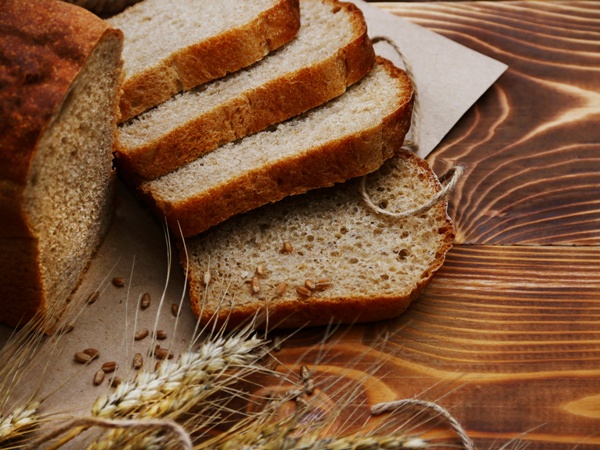
Gene edited foods have the potential to bring more than just on-farm benefits, though. CRISPR technology is relatively new, so while its potential is still untapped, there are a number of benefits it could bring directly to the consumer. Potential improvements may include:
- Foods like peanuts with allergen genes “turned off”
- Reduced-gluten wheat
- Improved vitamin levels or other nutritional improvements
- Flavor-enhanced food
We all eat, and we all want nutritious foods, especially for our children and grandchildren. Our food system in the U.S. is the safest system on the planet, and farmers like me are continuing to learn and improve how we grow it with the help of technologies like CRISPR.
If you have questions about CRISPR foods or would like to learn more about this technology, please don’t hesitate to reach out and ask.
Blockchain Food Traceability
Could blockchain be the answer to food traceability?
Blockchain, bitcoin, big data, etc. You might bundle all these words together and think that this technology is beyond what you’ll ever need or see used in the marketplace. But when it comes to knowing where your food comes from and how it was grown, blockchain food traceability is the future.
I farm in McLeansboro, IL and I can tell you that farmers aren’t new to data – in fact, we crunch numbers on a daily basis. Data helps us farm smarter and more sustainably. We are doing more with less every day and we constantly monitor the impact of our work on soil and water quality. Having this data means we can more aptly protect our natural resources for generations to come. Blockchain data in particular helps farmers give the entire food chain access to information about how food is grown – it’s digital transparency like we’ve never seen before.
Traceability
Blockchain is a way to connect people from farm to fork through data tracking technology. Using a blockchain food traceability system, a grocery store, food supplier or manufacturer can quickly and easily trace food back to its point of origin. Here’s how:
Blockchain is a traditional accounting ledger on steroids. This system logs transactions digitally and in a verifiable, permanent way. Blockchain can track things like the transfer of money or goods, or even certain activities. For example, if tillage was performed by a specific piece of equipment in a specific field, blockchain could track, verify and log it permanently. Once this is done, it cannot be changed or erased and is posted to the ledger for any user to access.

The ledger can be accessed through the blockchain website. By visiting blockchain.com/explorer, anyone can look up transactions made through blockchain technology. You could be walking through the grocery store and look up an item’s origin the same way you do with coupons before checkout!
Changing how we farm
Leaders in the agriculture industry are researching how blockchain could be used in production agriculture to benefit Illinois farmers like me. Blockchain is already using farm records to help make sure farmers get paid for their products and that customers understand what they’re buying. Right now, the most well-known example of a company using blockchain is Walmart, who is tracking their mangos from the farm to the store in a matter of seconds. Another example could be a grain company tracking a shipment of soybeans from the U.S. to China.
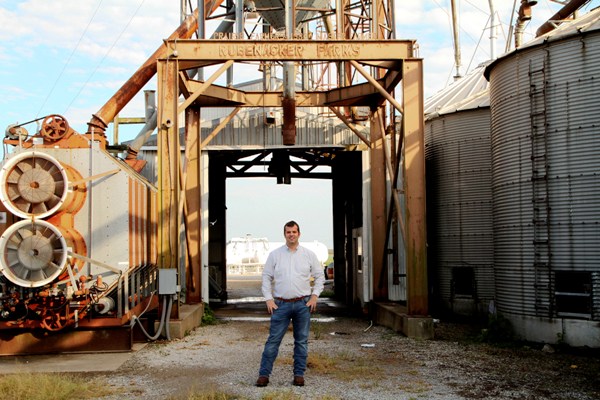
For consumers, it boils down to transparency. Everyone is curious about where their food comes from and how it impacts their plate. Blockchain food traceability enables consumers to go to the store, pick up their food and trust where their food was grown and if it was produced in the way it claims to be – potentially even discovering the farmer that grew the product.
If you thought that blockchain was beyond you, think again. Technology is revolutionizing agriculture, and consumers will enjoy the benefits just as much as we do.
Electronic Sow Feeders
#MomLife in the pig barn with electronic sow feeders
As a swine veterinarian, I work to support pig farmers by helping to provide the best possible care to their pigs. Specifically, I take care of sows (mother pigs) during breeding, pregnancy and nursing. Part of my job is to help farmers create an environment that promotes pig health and well-being. One piece of technology that can assist farmers caring for sows is electronic sow feeders (ESF).
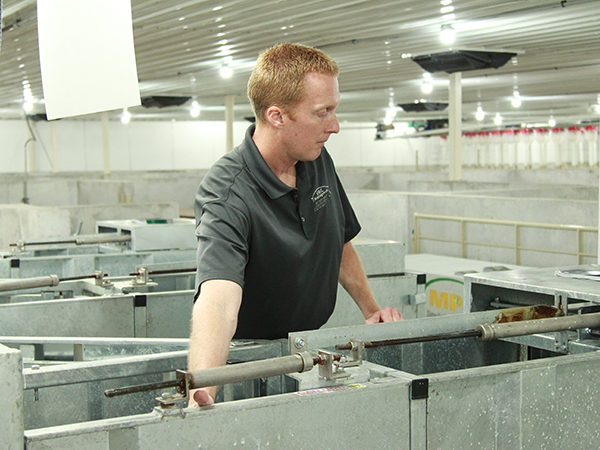
Electronic sow feeders are popular in Europe and are slowly making their way to U.S. farms. Traditionally, pregnant pigs have been placed in individual stalls where feed is directly supplied to them by farmers. Individual stalls have helped ensure pig health and proper nutrition by eliminating competition for food, but they have limited the sows’ ability to socialize and move around.
Pigs relax in an open pen and decide when it’s time to eat. Individual pigs enter the feeding stall and a door locks behind the pig to prevent mealtime competition from others.
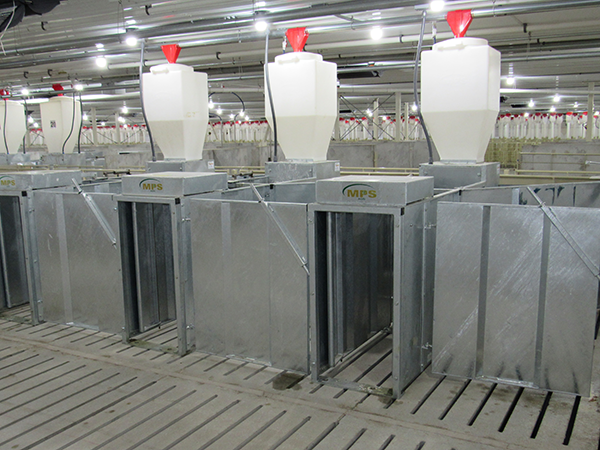
The pig’s ear tag is scanned by the feed machine and a personalized amount of food drops down. Once the pig is finished eating, she pushes through a door that leads back to the open pen.

Then the first door unlocks so the process can start again with the next hungry pig.
A few years ago, Sandy Creek Lane’s barn was custom built with the pigs’ well-being in mind and included electronic sow feeders and open pens. It takes our pigs about two to three weeks of training to get used to ESF. We help guide them into the feeding stall with food and water, where they are able to eat their meals in peace.
We have a computer in a room just outside the pen where we are provided daily reports. This report shows us the amount of feed every pig has eaten. The ESF technology allows us to track the feed consumption of each pig, just as we track the feed consumption of sows in stalls without the aid of the technology. When caring for pigs, it is important to keep an eye on how much sows are eating since a change in appetite can be one of the earliest indicators of illness or injury. As caregivers, we enjoy watching their feeding patterns through the system and being able to monitor every pig’s health on a personal basis.

When the pigs aren’t eating, the open pen allows for movement and social interaction. Pigs are naturally social creatures and like to lie in close physical contact with each other. They tend to lie down in rows within small nooks in the pen, designed for those after-dinner naps. Although social, food is always a source of competition. ESF helps to reduce this problem by only allowing one pig to eat at a time.
Our Illinois farm is packed full of interesting features that make it sustainable and safe for our pigs. If you’re curious, check out this fact sheet about our construction process and the benefits our farm was able to bring to our community.
Hi-Tech Dairy Barn
Hi-Tech Dairy Barn Improves Cow Comfort
My husband Andy and I began dairy farming with Andy’s parents in St. Charles in 2014. Like many young farmers, we were aware of the ways new technology could save time, improve animal comfort and increase sustainability. We wanted our dairy farm to be around for future generations of our family and decided that adding the latest technology to our barn was in our best interest and in the best interest of our cows.
Extreme Barn Makeover
It’s always been important that we take care of the cows and the people who take care of the cows. In December 2016 we began working on the design of the new barn with this concept in mind. Once the design was complete, our small family farm underwent its biggest renovation to date. In January 2019, we began milking cows in the new barn.
We built a custom barn outfitted with the latest technology for cow comfort, herd health and environmental sustainability:
Free Stalls
Cows are able to come and go throughout the barn to eat, sleep and drink as they please.
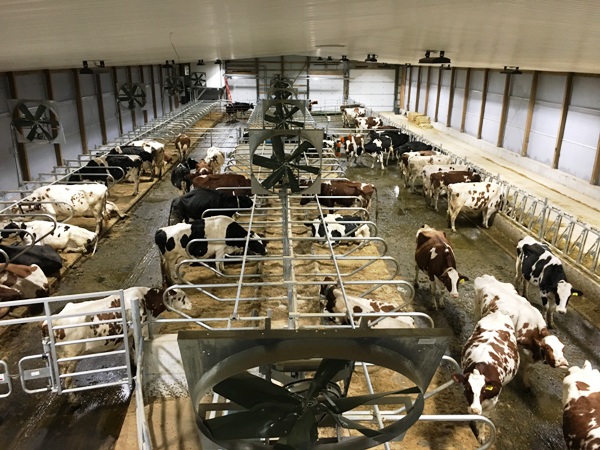
Rubber Flooring
The cows never have to stand or lie on concrete.
Robotic Feed Pusher
Cows can get a little messy with their food. Just like a Roomba spins through your house, this automated feed pusher keeps feed within reach of cows so they never go hungry.
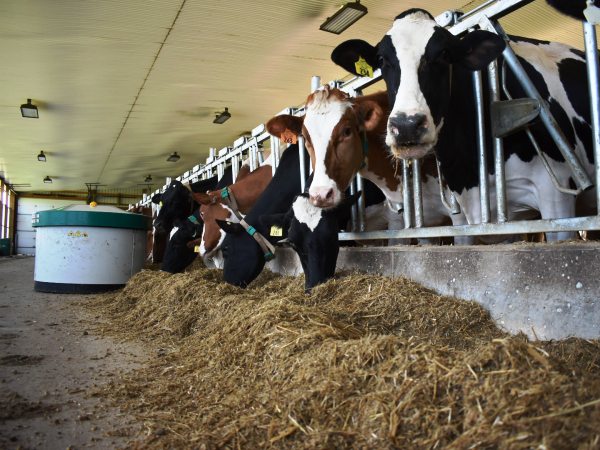
Herd Management Software
Special neck tags monitor individual cow health and activity.
Automatic Gate System
Just like at a theme park, automated gates help keep traffic flowing. The same technology is used on our farm so that all of our cows get milked in a timely manner.
Robotic Milkers
Robotic milkers use laser technology to accurately apply the milker to the cow’s udder. It’s very gentle and doesn’t hurt the cows. They walk right in when they are ready to be milked!

Manure Management System
A giant squeegee cleans manure from alleyways, separates the liquid and fiber portions and stores it for use.
Temperature-Controlled Barn
There are two sensors in the barn that control the lights, fans and curtains to maintain a comfortable environment for the cows.
Cow Brushes
Because sometimes, you have an itch you just can’t quite reach! It’s like an on-demand back scratch for the cows and it helps them stay clean, too.

For Love of Cows and Community
By making a safe, comfortable environment for both the cows and the people, we can provide top-quality milk for our local community. Our milk is shipped to Dean Foods in Rockford where it is made into cottage cheese and sour cream.
We cherish every moment spent with our cows; they are responsible for our successes. We are proud to give them a home that tends to their needs around the clock. From the baby calves in our calf barn to the 10-year-old cows in the milking barn, we enjoy working to provide our animals with the best care. We are especially proud when we see them reach exciting milestones like winning classes at the local fair or being classified as “excellent” by the Holstein Association.
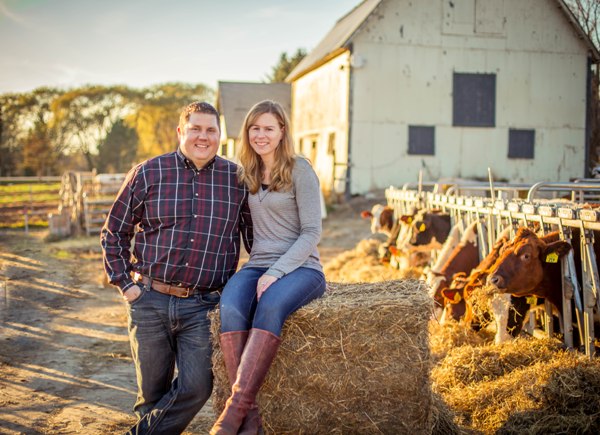
If you want to see our farm for yourself, our barn doors are open. We recently hosted an open house to show our community what modern farming looks like and we also offer tours to the public by appointment. We are eager to show people the technology used on our small dairy farm and answer every question they might have. We hope that it will serve as an opportunity for people from all walks of life to learn about the farmers and dairy cows behind the nutritious milk and dairy foods we all enjoy.
Better Beef Using Ultrasounds
THE SCIENCE BEHIND A STEAK
The cattle at the Larson Martz family farm get ultrasounds but not for the reason you might think. Experience and technology work together to help beef farmers determine when the time is right for an animal to go to market.
Like the old saying goes, practice makes perfect when it comes to raising cattle. As you gain experience raising cattle, you learn how to factor in age, weight and body condition to determine when they are ready to go to market.
While experience is still a key component in raising cattle, technology has come a long way in taking some of the guess-work out of beef farming. Today, we use ultrasound technology to know exactly when an animal is ready to go to market.
It’s all about marbling
If you’ve ever googled how to pick a good steak, the first tip you probably found was to look for good marbling. Marbling is the intramuscular fat – those white flecks you see dispersed throughout the meat. That is where the juicy flavor comes from, and it’s primarily unsaturated fat so you can feel good eating it! When you’re looking for quality meat, marbling is key.
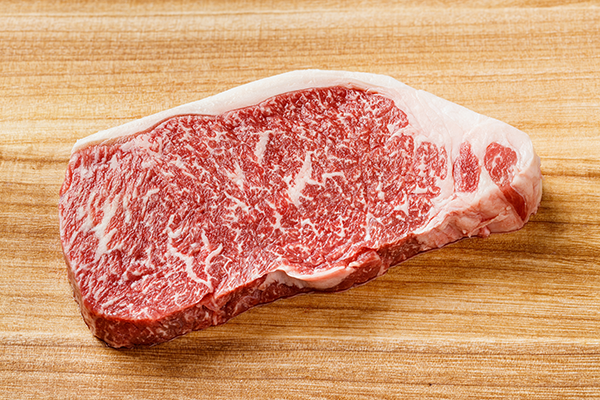
Raising cattle is a science
While a group of cattle may get fed the same diet for the same amount of time, cattle will grow and develop differently due to their genetic makeup.
Rather than assuming a whole group of cattle will perform the same based on their age and weight, we ultrasound our cattle 100 days before we expect them to be ready for market. This allows us to treat them as individuals and adjust that projected market date if necessary. Ultrasound technology ensures every animal that leaves our farm will deliver high-quality beef to the end consumer.
Here’s how it works:
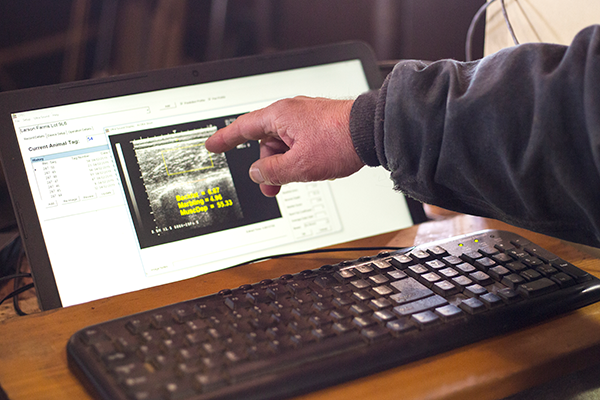
By placing an ultrasound transducer on an animal’s back, we can see the layers of bone, muscle and fat. The grey strip in the middle of the image is the muscle, a.k.a. meat. The white line at the top of the screen is a layer of back fat. This is the fat that is normally trimmed off of the outer edge of a steak (saturated fat).
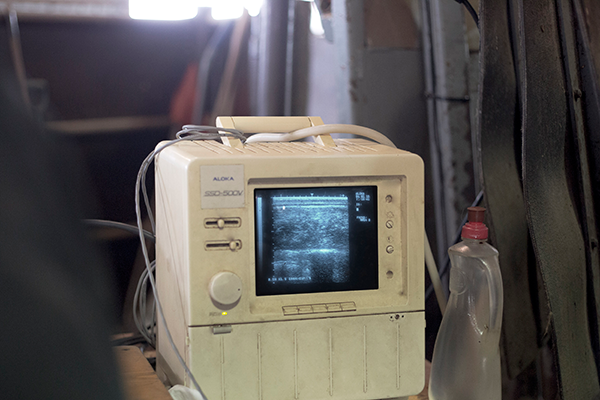
The white flecks within the grey are the marbling we want to see. Rather than relying on an animal’s age and weight to determine when they are market ready, we can look directly at the trait that is most important to our customers: marbling. Once the maximum marbling is obtained for an individual animal’s potential, that animal is ready to go to market.
Quality vs. Quantity
Over the years, this technology has helped us improve overall meat quality. We share our data with the farmers we buy calves from so they can know which cows and bulls are producing animals that genetically lend themselves to excellent marbling. Using that information, they improve their herd’s genetics and sell us animals that produce high-quality meat more efficiently. This improves our farm’s sustainability by having cattle that grow using fewer resources.
We’ve built our reputation on quality beef and take great pride in providing beef that makes people come back for more.
Dairy Farm Sustainability
ONE “WHEY” OR ANOTHER – DAIRY FARM SUSTAINABILITY
When my sister and I took over our family dairy farm a few years ago, we decided a new adventure was in store for the Marcoot Jersey Farm in Greenville, Illinois – and by “adventure,” I mean cheese.
Based on the current demand for milk and milk prices, we had two options to remain profitable and stay in business: get roughly 400 more cows or find another way to increase revenue. For our farm and family, thinking outside the box and creating a value-added income stream felt like the right choice. And so, the creamery where we make artisan and farmstead cheese was born.

Say “Cheese!”
Our 110 Jersey cows supply all of the milk to make our cheese. The beautiful Jersey cow is known for producing rich, high-quality milk with lots of butterfat, making it perfect for cheese.
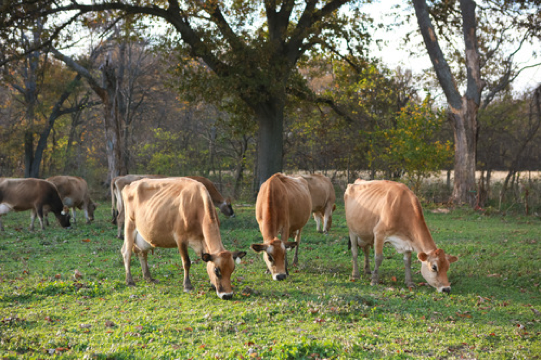
All of our cheeses are made right here on the farm and aged in our underground aging cave. The cheese cave is designed after the man-made cheese caves in Switzerland to provide natural aging for our cheese while providing energy efficiency and sustainability for the creamery.
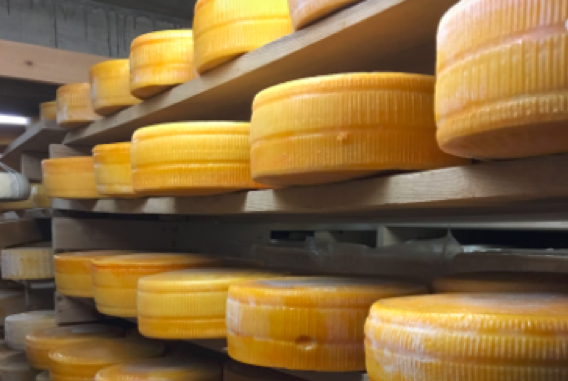
Sustainability is a key component for our family and farm. It guides the methods in which we take care of our herd, the way we produce our cheese and the way we designed our facility. We combine centuries old methods like the cheese cave with new technologies that allow us to use every part of the milk our cows produce.
The result: Delicious cheese with zero waste.
“Whey” To Recycle
Whey is the liquid left over from the cheese making process. Cheese is made up of the solid parts of milk, so, naturally, after you make cheese, you are left with the liquid parts. This liquid has protein in it, which is why you’re probably most familiar with whey as a dehydrated protein powder.
Creameries in the Wisconsin area can sell their whey to processors who dehydrate it and use it in various ways. In Southern Illinois, we don’t have access to that market, so we had to start coming up with other “wheys” to make this cheese by-product a value-added piece of our business.
Audie, our resident cheese maker, got to work on some ideas. For a while, we used the sweet cream whey as a feed additive for our cattle. They loved the sweet taste, and it packed a punch as an extra (and affordable) protein source for optimal nutrition.
Next, she came up with Extreme Ice. It’s our own version of Italian ice but with an extra boost of protein. It combines sweet cream whey with frozen fruit to provide 20 grams of protein in a 5-oz. serving. Delicious and nutritious!
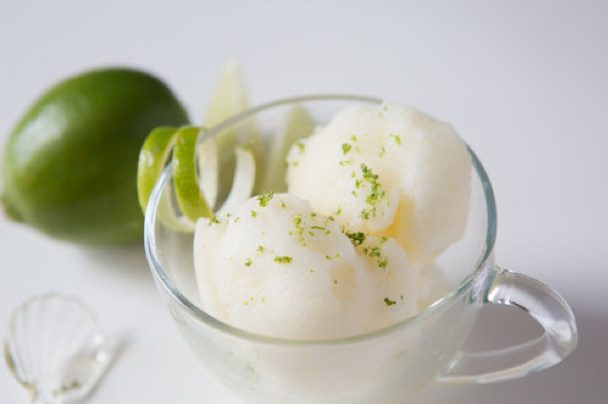
Our next challenge will be finding a distributor to work with so we can bring this high-protein frozen treat to people beyond those who visit our creamery. After all, the more cheese we make, the more whey we have to utilize.
Carrying on the family heritage on our dairy farm is important to us, but doing things the same way just wasn’t a viable option. To keep the family business thriving, we had to come into it with an open mind and willingness to try new things. Even though our family business looks different today, our family’s core values remain the same: responsibly raised cows, sustainable dairy products and a deep love for Jersey cows.
Tech and Nature Collide to Clean Water
Tech and Nature Collide to Clean Water
When you pour your leftover juice down the drain or take a shower, you probably don’t think much about where that water goes. Maybe that’s because we live in a day and age when proper water treatment and handling are a luxury that most of us have in our homes and cities. On the farm, however, we think a lot about where our water goes and the effects it can have on our environment and our neighbors downstream.
Nitrate is a four-letter word
Nitrates – maybe you’ve heard of them, and maybe you haven’t, but it’s a word we use a lot on the farm. A nitrate is a compound that is naturally formed when nitrogen interacts with oxygen. All living things require nitrogen, but high levels of nitrates in our water supply can be problematic. Since nitrates are naturally created by plants and animals as well as some of the nitrogen fertilizers we use in our fields to help crops grow, we are always monitoring the nitrate levels in our water.
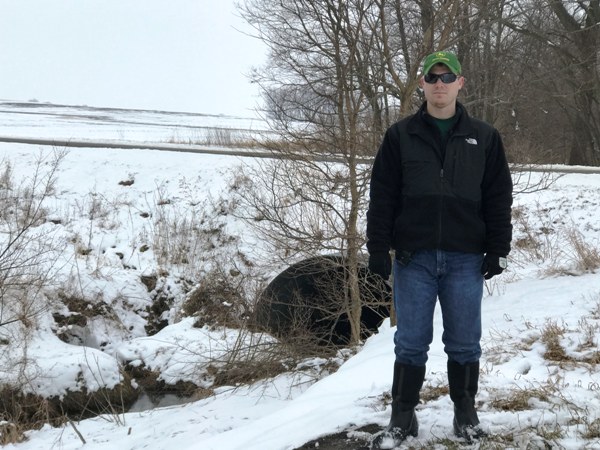
Conservation practices like cover crops, reduced tillage and thoughtfully calculated fertilizer applications have all made an impact on our farm’s water quality. But most recently, we installed a bioreactor that goes one step further to remove nitrates from water before it leaves our farm.
How it works
After rainfall, water naturally accumulates and runs towards the nearest stream or pond. For the bioreactor, we dug a trench where water naturally flows on my farm and filled it with woodchips. Microorganisms in the woodchips clean the nitrates out of the water by a process similar to breathing. Just like we inhale oxygen and exhale carbon dioxide, these microorganisms inhale the nitrates and exhale nitrogen gas before the water leaves my farm.
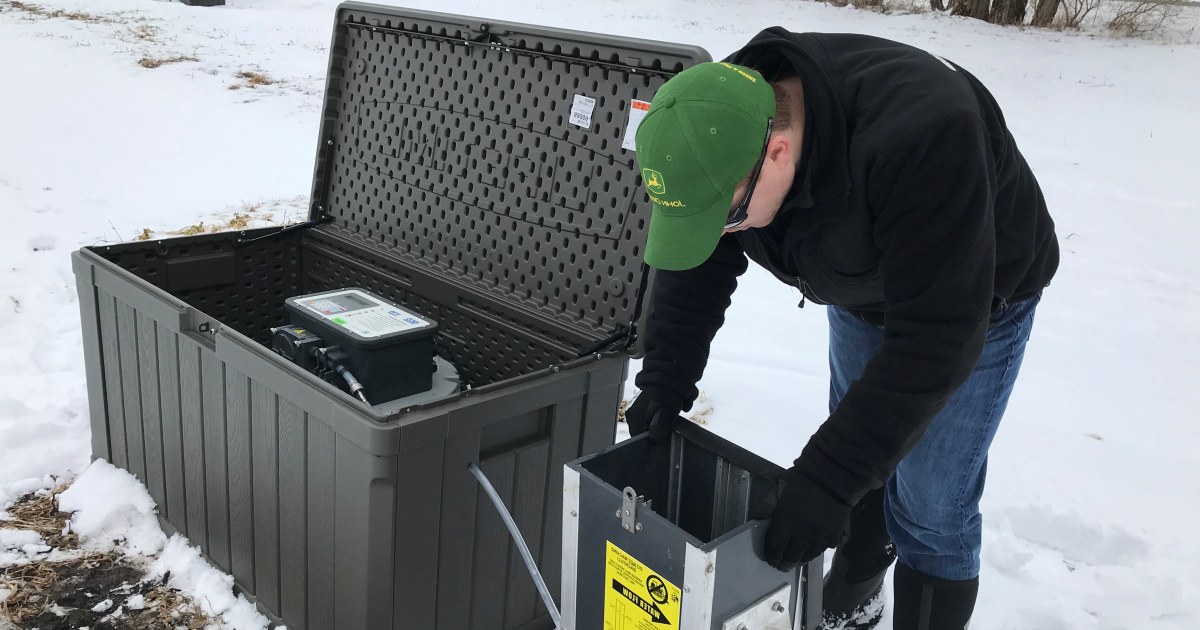
This box contains an auto sampler that is connected to my tile lines (underground drainage lines that keep water from pooling on my fields). The University of Illinois is using my bioreactor for research, so they need to be able to sample water as it enters and leaves the bioreactor. These auto samplers are set on a timer and pull samples automatically so that the water can be analyzed for nitrate levels.
I couldn’t do it alone
Ask just about any farmer, and they will tell you they don’t do it alone. Farming takes a lot of teamwork and resources, and getting this bioreactor installed on our farm was no exception.
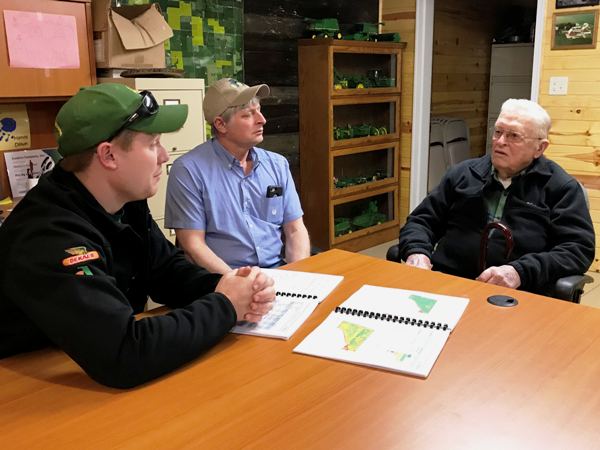
I have a long-standing relationship with my Crop Advisor, Malcom. He shares my passion for minimizing nutrient loss on the farm and has helped me implement new strategies on the farm and monitor our progress. I am also active with the Illinois Farm Bureau and have taken advantage of some tours and learning opportunities through their programs. One of those programs gave me the opportunity to set this bioreactor up on my farm.
I am beyond excited to improve our water quality, but it is likely something I wouldn’t have been able to afford to install on my own. At the end of the day, it takes research and technology to develop new conservation strategies, but none of it works without partners and experts who are willing to help you succeed.
My dad and grandpa have always been among the first to try new conservation methods and have really set the stage for where our farm is at today. They are a great example of what it means to be a steward of the land and have instilled in me the courage and mindset to keep trying. I’m excited to bring this technology to our farm and see the difference it can make in keeping our environment healthy.
Sustainability Calculator
SCORE ONE FOR FARM SUSTAINABILITY
Sustainability: a whole food system approach
I’m in the food business. Like you and everyone in the food supply chain, from farmers to ingredient processors to brands and retailers, I want a sustainable food supply. That means food companies work with farmers to set specific sustainability standards and source ingredients based on those standards.

Low score wins
The Fieldprint® Calculator app helps farmers measure and track environmental impact. I grow corn, soybeans and wheat on my farm in central Illinois. After harvest each year, I input data into the calculator and it gives me a score based my estimated carbon footprint. The scoring system is similar to golf – the lower the score the better.
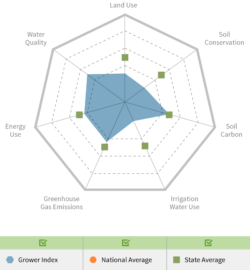 The score is based on a variety of factors including:
The score is based on a variety of factors including:
- Trips across the field (fuel use and greenhouse gas emissions)
- Fertilizer used (when and how much)
- Pesticides used (when and how much)
- Biodiversity
- Soil conservation
- Water quality
Calculating change
Next, I review a “web graph” that represents my sustainability performance compared to state and national averages. I use the results to think critically about what I could improve on my farm next year. Personally, what I value most is being able to see how my farm compares to my neighbors because they have to deal with the same weather, pests and soil that I do.
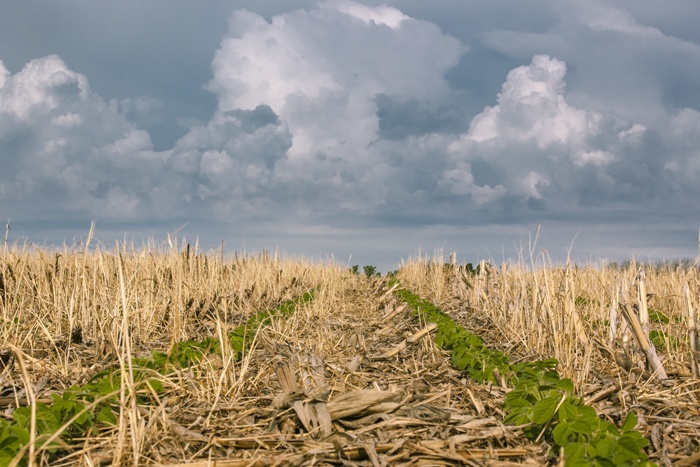
Data drives decisions
Before this calculator, I used soil conservation practices including cover crops and minimal tillage, both of which help prevent erosion and increase organic matter in the soil. When I first began using the calculator, I was happy to see that my score was already low and I was doing excellent work in many categories. There was, however, one category that I didn’t score as well in: fertilizer use.
I applied the same amount of fertilizer to all areas of my fields at the time, but looked into other options once I knew there was room for improvement. Now, I apply fertilizer at a variable rate, meaning my field is split into sections and I only apply as much fertilizer as each individual section needs based on soil test results. It’s like each acre of my field has it’s own prescription. Giving the soil only as much fertilizer as it needs reduces waste and has improved my score in the Fieldprint® Calculator app.
We all need to be profitable
To me, sustainability is about conservation practices, but it’s also about profitability. I believe the two go hand-in-hand. After all, a farmer can’t keep using sustainability measures without succeeding in their business. The calculator app is a great way for farmers to benchmark change and justify conservation methods that can improve their land and their bottom line.
CowManager Eartag
Tracking Tag Keeps Cows Connected
Over the years, our farm, like our family, has grown. One of our most important jobs on the farm is keeping every animal healthy. As a parent, you can relate. A look into your kids’ eyes or a quick hand on the forehead can tell you if they’re not feeling great. While we interact with our animals every day, we are still vastly outnumbered by our 500 dairy cows.
That’s why our cows wear Fitbits … sort of.
 Individual Care
Individual Care
Accurate information about cow health is an absolute must for dairy farmers. The more you know about how your animals are feeling, the better care you can provide for them. One of the ways you can do this is by using technology that helps you monitor your cows’ health and well-being, even before they show signs of illness.
The CowManager tool was developed to provide farmers with real-time information about each one of their cows. Each cow wears an ear tag that is similar to a Fitbit, but it tracks more than just the steps a cow takes. It also tracks their food intake and other vital signs that have changed the way dairy farmers manage their cows’ reproduction and overall health.
By monitoring their cows’ conditions with precision, dairy farmers are able to give their cows the individual attention and care they need.
Early Detection
Using this technology on our farm saves us time and improves the general health of our cows. And, of course, happy cows make more milk. The CowManager tool gives us immediate information about every cow’s:
- Temperature (early indicator of illness)
- Cycle (best time to get pregnant based on her natural cycle)
- Activity (eating, sleeping and movement patterns)
- Rumination (digestion and diet)
Just like with human health, early detection can make an injury or illness much easier to treat. Early intervention means there are fewer major health issues, a reduced need for antibiotics and healthier cows.
Round-the-Clock Care
By looking on our smartphone or computer, we have the ability to monitor our cows 24/7 – whether we’re in the barn, in bed or in another country. The CowManager tool gives us real-time information so we can make real-time decisions that can make or break our herd health.
Keeping cows healthy is every farmer’s goal, and it’s a lofty goal when you are responsible for 500 of them. Technology like our CowManager system helps us make decisions that can reduce the resources we use, conserve energy and the environment, and keep our animals happy and healthy.
At the end of the day, it is still up to us to know when to act and how to best care for our cows, but this ear tag technology gives us the information we need to do our best work.




